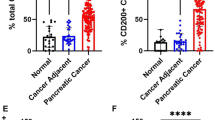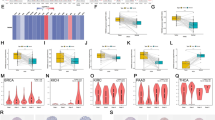Abstract
Development of more effective therapeutic strategies for cancers of high unmet need requires the continued discovery of disease-specific protein targets for therapeutic antibody targeting. In order to identify novel proteins associated with cancer cell invasion/metastasis, we present here an alternative to antibody targeting of cell surface proteins with an established role in invasion; our functional antibody screening approach involves the isolation and selection of MAbs that are primarily screened for their ability to inhibit tumour invasion. A clonal population of the Mia PaCa-2, a pancreatic ductal adenocarcinoma (PDAC) cell line, which displays a highly invasive phenotype, was used to generate MAbs with the objective of identifying membrane targets directly involved in cancer invasion. Selected MAb 7B7 can significantly reduce invasion in a dose-responsive manner in Mia PaCa-2 clone 3 and DLKP-M squamous lung carcinoma cells. Using immunoprecipitation and liquid chromatography-tandem mass spectrometry (LC-MS-MS) analysis, the target antigen of anti-invasive antibody, 7B7, was determined to be the heterodimeric Ku antigen, Ku70/80, a core protein composed of the Ku70 and Ku80 subunits which is involved in non-homologous end-joining (NHEJ) DNA repair. RNA interference-mediated knockdown of Ku70 and Ku80 resulted in a marked decrease in the invasive capacity of Mia PaCa-2 clone 3 and DLKP-M cells, indicating that Ku70/Ku80 is functionally involved in pancreatic and lung cancer invasion. Immunohistochemical analysis demonstrated Ku70/Ku80 immunoreactivity in 37 PDAC tumours, indicating that this heterodimer is highly expressed in this aggressive cancer type. This study demonstrates that a functional MAb screening approach coupled with immunoprecipitation/proteomic analyses can be successfully applied to identify functional anti-invasive MAbs and potential novel targets for therapeutic antibody targeting.







Similar content being viewed by others
References
Eckhardt BL, Francis PA, Parker BS, Anderson RL. Strategies for the discovery and development of therapies for metastatic breast cancer. Nat Rev Drug Disc. 2012;11:479–97.
Weber GF. Why does cancer therapy lack effective anti-metastasis drugs? Cancer Lett. 2013;328:207–11.
Scott AM, Allison JP, Wolchok JD. Monoclonal antibodies in cancer therapy. Cancer Immun. 2012;12:14.
Chames P, Van Regenmortel M, Weiss E, Baty D. Therapeutic antibodies: successes, limitations and hopes for the future. Br J Pharmacol. 2009;157(2):220–33.
Lambert JM. Drug-conjugated antibodies for the treatment of cancer. Br J Clin Pharmacol. 2013;76(2):248–62. doi:10.1111/bcp.12044.
Reichert JM. Antibodies to watch in 2014. MAbs. 2013 Nov 25;6(1). [Epub ahead of print]
Scott AM, Wolchok JD, Old LJ. Antibody therapy of cancer. Nat Rev Cancer. 2012;12(4):278–87.
Sliwkowski MX, Mellman I. Antibody therapeutics in cancer. Science. 2013;341(6151):1192–8.
Mullard A. Maturing antibody-drug conjugate pipeline hits 30. Nat Rev Drug Discov. 2013;12(5):329–32.
Sievers EL, Senter PD. Antibody-drug conjugates in cancer therapy. Annu Rev Med. 2013;64:15–29.
Roti G, Stegmaier K. Genetic and proteomic approaches to identify cancer drug targets. Br J Cancer. 2012;106(2):254–61.
Swinney DC, Anthony J. How were new medicines discovered? Nat Rev Drug Discov. 2011;10(7):507–19.
Kohler G, Milstein C. Continuous cultures of fused cells secreting antibody of predefined specificity. Nature. 1975;256(5517):495–7.
Kinch MS, Kohli M, Goldblatt M, Li WB. Function-first approaches to improve target identification in cancer. Future Oncol. 2009;5(5):617–23.
Frendeus B. Function-first antibody discovery: embracing the unpredictable biology of antibodies. Oncoimmunol. 2013;2(8):e25047.
Rust S, Guillard S, Sachsenmeier K, Hay C, Davidson M, Karlsson A, et al. Combining phenotypic and proteomic approaches to identify membrane targets in a 'triple negative' breast cancer cell type. Mol Cancer. 2013;12:11.
Walsh N, Dowling P, O'Donovan N, Henry M, Meleady P, Clynes M. Aldehyde dehydrogenase 1A1 and gelsolin identified as novel invasion-modulating factors in conditioned medium of pancreatic cancer cells. J Proteomics. 2008;71(5):561–71.
McBride S, Meleady P, Baird A, Dinsdale D, Clynes M. Human lung carcinoma cell line DLKP contains 3 distinct subpopulations with different growth and attachment properties. Tumour Biol. 1998;19(2):88–103.
Walsh N, Clynes M, Crown J, O'Donovan N. Alterations in integrin expression modulates invasion of pancreatic cancer cells. J Exp Clin Cancer Res. 2009;28:140.
Albini A. Tumor and endothelial cell invasion of basement membranes. The matrigel chemoinvasion assay as a tool for dissecting molecular mechanisms. Pathol Oncol Res. 1998;4(3):230–41.
Martin A, Clynes M. Acid phosphatase: endpoint for in vitro toxicity tests. In Vitro Cell Dev Biol. 1991;27A(3 Pt 1):183–4.
Shevchenko A, Tomas H, Havlis J, Olsen JV, Mann M. In-gel digestion for mass spectrometric characterization of proteins and proteomes. Nat Protoc. 2006;1(6):2856–60.
Larkin A, Moran E, Kennedy SM, Clynes M. Monoclonal antibody 5C3 raised against formalin fixed paraffin-embedded invasive breast tumour tissue: characterisation of its reactive antigen via immunoprecipitation and internal sequencing. J Immunol Methods. 2005;303(1–2):53–65.
Beck A, Wurch T, Bailly C, Corvaia N. Strategies and challenges for the next generation of therapeutic antibodies. Nat Rev Immunol. 2010;10(5):345–52.
Tuteja N, Tuteja R, Ochem A, Taneja P, Huang NW, Simoncsits A, et al. Human DNA helicase II: a novel DNA unwinding enzyme identified as the Ku autoantigen. EMBO J. 1994;13(20):4991–5001.
Muller C, Paupert J, Monferran S, Salles B. The double life of the Ku protein: facing the DNA breaks and the extracellular environment. Cell Cycle. 2005;4(3):438–41.
Cosaceanu D, Budiu RA, Carapancea M, Castro J, Lewensohn R, Dricu A. Ionizing radiation activates IGF-1R triggering a cytoprotective signaling by interfering with Ku-DNA binding and by modulating Ku86 expression via a p38 kinase-dependent mechanism. Oncogene. 2007;26(17):2423–34.
Jia Q, Li Y, Xu D, Li Z, Zhang Z, Zhang Y, et al. Radiosensitivity of glioma to Gamma Knife treatment enhanced in vitro and in vivo by RNA interfering Ku70 that is mediated by a recombinant adenovirus. J Neurosurg. 2010;113(Suppl):228–35.
SoderlundLeifler K, Queseth S, Fornander T, Askmalm MS. Low expression of Ku70/80, but high expression of DNA-PKcs, predict good response to radiotherapy in early breast cancer. Int J Oncol. 2010;37(6):1547–54.
Hassan MK, Watari H, Christenson L, Bettuzzi S, Sakuragi N. Intracellular clusterin negatively regulates ovarian chemoresistance: compromised expression sensitizes ovarian cancer cells to paclitaxel. Tumour Biol. 2011;32(5):1031–47.
Petera J, Sirak I, Beranek M, Vosmik M, Drastikova M, Paulikova S, et al. Molecular predictive factors of outcome of radiotherapy in cervical cancer. Neoplasma. 2011;58(6):469–75.
Bouchaert P, Guerif S, Debiais C, Irani J, Fromont G. DNA-PKcs expression predicts response to radiotherapy in prostate cancer. Int J Radiat Oncol Biol Phys. 2012;84(5):1179–85.
Groselj B, Kerr M, Kiltie AE. Radiosensitisation of bladder cancer cells by panobinostat is modulated by Ku80 expression. Radiother Oncol. 2013;108(3):429–33.
Ma Q, Li P, Xu M, Yin J, Su Z, Li W, et al. Ku80 is highly expressed in lung adenocarcinoma and promotes cisplatin resistance. J Exp Clin Cancer Res. 2012;31:99.
Monferran S, Paupert J, Dauvillier S, Salles B, Muller C. The membrane form of the DNA repair protein Ku interacts at the cell surface with metalloproteinase 9. EMBO J. 2004;23(19):3758–68.
Persson O, Salford LG, Fransson J, Widegren B, Borrebaeck CA, Holmqvist B. Distribution, cellular localization, and therapeutic potential of the tumor-associated antigen Ku70/80 in glioblastoma multiforme. J Neuro Oncol. 2010;97(2):207–15.
Fransson J, Borrebaeck CA. The nuclear DNA repair protein Ku70/80 is a tumor-associated antigen displaying rapid receptor mediated endocytosis. Int J Cancer. 2006;119(10):2492–6.
Lagadec C, Romon R, Tastet C, Meignan S, Com E, Page A, et al. Ku86 is important for TrkA overexpression-induced breast cancer cell invasion. Proteomics Clin Appl. 2010;4(6–7):580–90.
Alshareeda AT, Negm OH, Albarakati N, Green AR, Nolan C, Sultana R, et al. Clinicopathological significance of KU70/KU80, a key DNA damage repair protein in breast cancer. Breast Cancer Res Treat. 2013;139(2):301–10.
Li W, Xie C, Yang Z, Chen J, Lu NH. Abnormal DNA-PKcs and Ku 70/80 expression may promote malignant pathological processes in gastric carcinoma. World J Gastroenterol. 2013;19(40):6894–901.
Ferenczi K, Ohtola J, Aubert P, Kessler M, Sugiyama H, Somani AK, et al. Malignant T cells in cutaneous T-cell lymphoma lesions contain decreased levels of the antiapoptotic protein Ku70. Br J Dermatol. 2010;163(3):564–71.
Pucci S, Mazzarelli P, Sesti F, Boothman DA, Spagnoli LG. Interleukin-6 affects cell death escaping mechanisms acting on Bax-Ku70-Clusterin interactions in human colon cancer progression. Cell Cycle. 2009;8(3):473–81.
Korabiowska M, Tscherny M, Stachura J, Berger H, Cordon-Cardo C, Brinck U. Differential expression of DNA nonhomologous end-joining proteins Ku70 and Ku80 in melanoma progression. Mod Pathol. 2002;15(4):426–33.
Azmi AS, Philip PA, Aboukameel A, Wang Z, Banerjee S, Zafar SF, et al. Reactivation of p53 by novel MDM2 inhibitors: implications for pancreatic cancer therapy. Curr Cancer Drug Targets. 2010;10(3):319–31.
Acknowledgments
This work was funded by Enterprise Ireland, project code TD/2009/0133. The authors wish to acknowledge the technical assistance provided by the RCSI Biomedical Facility, Beaumont Hospital, Dublin 9, Ireland.
Author information
Authors and Affiliations
Corresponding author
Additional information
Dermot O’Sullivan and Michael Henry contributed equally to this study.
Electronic supplementary material
Below is the link to the electronic supplementary material.
ESM 1
(DOCX 5003 kb)
Rights and permissions
About this article
Cite this article
O’Sullivan, D., Henry, M., Joyce, H. et al. 7B7: a novel antibody directed against the Ku70/Ku80 heterodimer blocks invasion in pancreatic and lung cancer cells. Tumor Biol. 35, 6983–6997 (2014). https://doi.org/10.1007/s13277-014-1857-5
Received:
Accepted:
Published:
Issue Date:
DOI: https://doi.org/10.1007/s13277-014-1857-5




